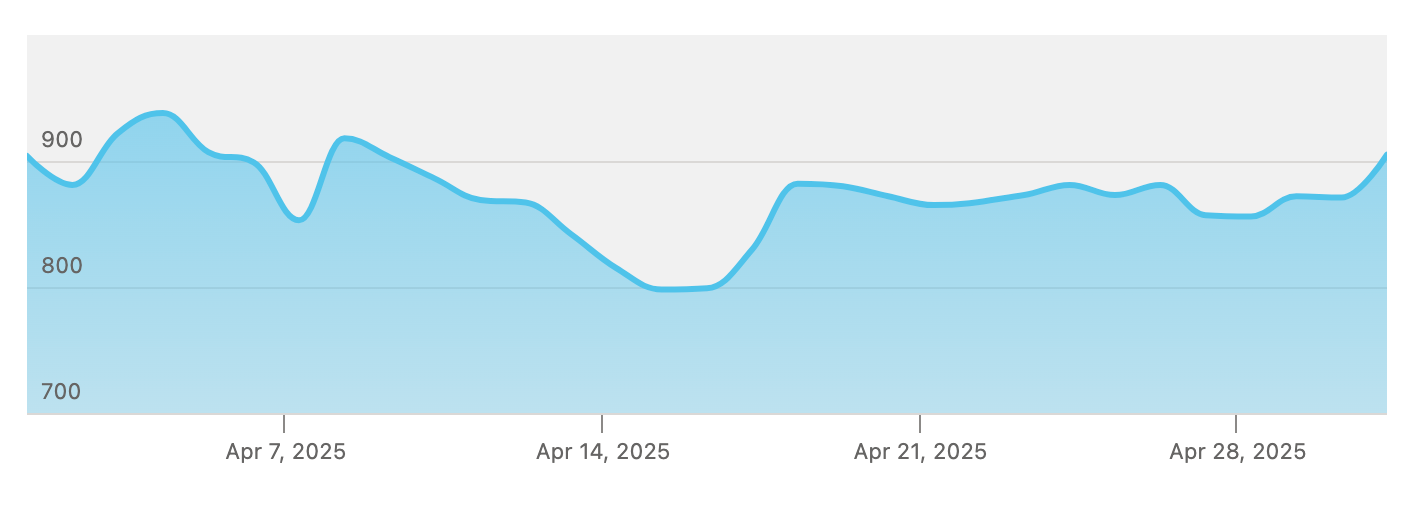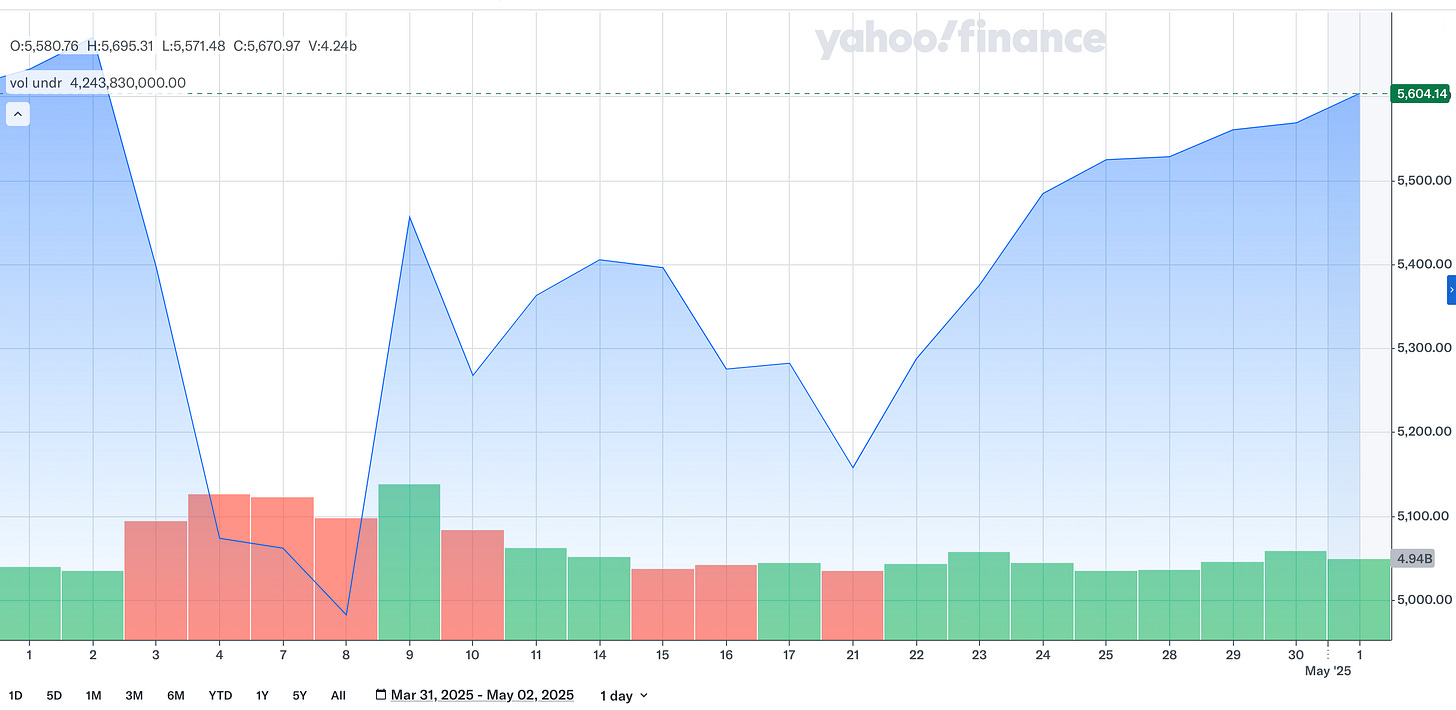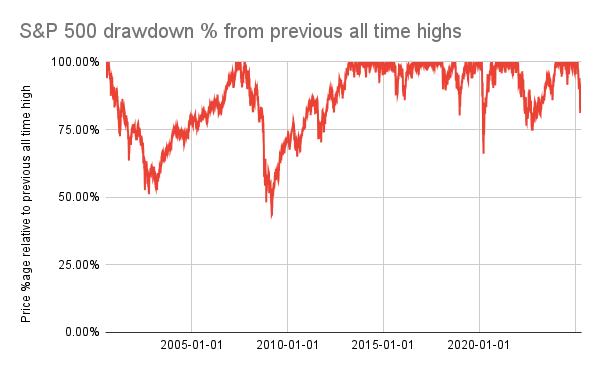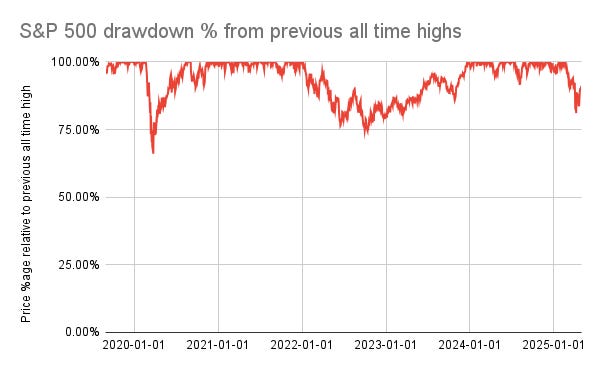What Just Happened? April’s Markets in Rewind
A 30-day rollercoaster brought us full circle. But should we treat it as a return to normal — or a warning shot?
Let’s start by looking at this 30-day chart:
As you can see, things looked pretty good heading into April. The chart hits an all-time high early in the month, then dips, dips, and dips again—bottoming out mid-April—before clawing its way back to within a whisker of where it started. Can you guess what investment this is? Or what this chart even represents? I’ll give you a second to think about it.
…
…
…
You're probably wrong.
This is the chart of my Rapid Chess rating on Chess.com. I hit a high of 938 on April 4th, then went on a massive losing streak. By mid-April, I was in the dumps—but I’ve since recovered to 905, just 4% off the peak. Yes, it looks and feels like the S&P 500 chart for April, but any and all correlation is purely coincidental.
(♔ ♔ ♔ Or is it? Do my chess skills go up and down with the markets? ♔ ♔ ♔ )
Anyway, let’s switch back to investing talk.
Phew—what a month April was.
The S&P followed a very similar path, as you may have guessed. Trump came out swinging—upending the world order around globalization and trade, irritating allies and foes alike. Countries scrambled to respond, markets went into a tailspin, investors started hyperventilating... and by the end of the month, the market (made up of said investors) essentially said, “f-off,” and rallied right back to where it began.
If you went into a coma on April 1st and woke up on May 1st, you’d barely notice anything had happened, just by looking at start and end prices.
The general narrative for the S&P 500 since the end of the financial crisis has been: buy and hold. If the market dips—buy the dip. And that’s worked brilliantly for investors. Yes, there have been drawdowns, but most were short-lived and relatively mild. Exceptions include the rapid downturn during the onset of COVID, and the more drawn-out pullback in 2022. April’s drama looks almost benign in comparison.
As regular readers know, I tend to swing between optimism and skepticism on the S&P 500’s prospects. I’ve written bullish takes in posts Never Bet Against America, S&P 500 in Coffee Can Mode, and Markets have sneezed - what next—highlighting the index’s resilience and benefiting from those bets. But from posts Navigating the Next Decade and From Dominance to Dilemna earlier this year, I not only exited some of those positions, I also started actively exploring alternatives. My bearish thesis from earlier this year still stands, and it boils down to three core concerns:
The index is extremely expensive—which tends to correlate with poor future returns.
It’s heavily concentrated in a few stocks priced for perfection—never a great setup.
The exceptional run of recent years has lulled us into thinking this is normal—but what if it’s not?
Since I laid out those concerns (and took real investing action based on them), we’ve had the Trump Tariff Tantrum—let’s call it TTT for short. Whether or not he follows through on the tariffs, the very fact that he said what he said has implications. Capital allocators—people deciding where to put real money into real-world things like factories, shipping routes, and warehouses—are now forced to consider a shifting world order. That genie’s out of the bottle.
More uncertainty means more hesitation. And that hesitation creates real economic drag.
Or so the theory goes.
In light of all that, the market pullback made sense to me. What doesn’t quite add up is the snap-back to bullishness. And yet, here we are. The S&P 500 is now just a hop, skip, and jump away from all-time highs.
So where does that leave investors?
Buy the dip (from earlier this year)? Or stay cautious and seek out alternative assets?
Honestly—I don’t know. Theory and reality seem to be diverging away more and more. I’m comfortable with what I own, which is pretty far removed from the S&P 500, and I’m reasonably confident it’ll make sense over time. But who knows?
To put it together then, markets may be flirting with new highs, and my chess rating may still be licking its wounds—but both remind me that reversals are part of the game. Whether you’re moving pawns or money, just don’t let short-term swings knock you off your long-term plan.
And if you’re unsure what to do next? Maybe play a game of chess. It’s cheaper than FOMO. On that note, Happy Investing!
Disclaimer: I am not your financial advisor and bear no fiduciary responsibility. This post is only for educational and entertainment purposes. Do your own due diligence before investing in any securities. I may hold or enter into, a position in any of the stocks mentioned above. The above is NOT a solicitation to either buy or sell the securities listed in this post.





